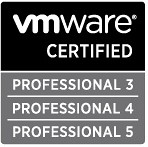In the vSphere Client, each storage device, or LUN, is identified by several names, including a friendly name, a UUID, and a runtime name.
Name
This is a friendly name that the ESXi host assigns to a device based on the storage type and manufacturer. You can modify the name using the vSphere Client. When you modify the name of the device on one host, the change takes affect across all hosts that have access to this device.
This is a friendly name that the ESXi host assigns to a device based on the storage type and manufacturer. You can modify the name using the vSphere Client. When you modify the name of the device on one host, the change takes affect across all hosts that have access to this device.
Identifier
This is a universally unique identifier assigned to a device. Depending on the type of storage, different algorithms are used to create the identifier. The identifier is persistent across reboots and must be the same for all hosts sharing the device.
This is a universally unique identifier assigned to a device. Depending on the type of storage, different algorithms are used to create the identifier. The identifier is persistent across reboots and must be the same for all hosts sharing the device.
Runtime Name
This is the name of the first path to the device. The runtime name is created by the host, is not a reliable identifier for the device, and is not persistent.
The runtime name has the following format: vmhba#:C#:T#:L#.
This is the name of the first path to the device. The runtime name is created by the host, is not a reliable identifier for the device, and is not persistent.
The runtime name has the following format: vmhba#:C#:T#:L#.
vmhba#
The name of the storage adapter. The name refers to the physical adapter on the host, not to the SCSI controller used by the virtual machines.
C#
The storage channel number. Software iSCSI initiators use the channel number to show multiple paths to the same target.
The storage channel number. Software iSCSI initiators use the channel number to show multiple paths to the same target.
T#
The target number. Target numbering is decided by the host and might change if there is a change in the mappings of targets visible to the host. Targets that are shared by different ESXi hosts might not have the same target number.
The target number. Target numbering is decided by the host and might change if there is a change in the mappings of targets visible to the host. Targets that are shared by different ESXi hosts might not have the same target number.
L#
The LUN number that shows the position of the LUN within the target. The LUN number is provided by the storage system. If a target has only one LUN, the LUN number is always zero (0).
For example, vmhba1:C0:T3:L1 represents LUN1 on target 3 accessed through the storage adapter vmhba1 and channel 0.
For example, vmhba1:C0:T3:L1 represents LUN1 on target 3 accessed through the storage adapter vmhba1 and channel 0.
Source – ESXi Configuration Guide


tsentekin
/ January 5, 2012is there a script to find the spesific L# in the datastore and add that lun as RDM to a vm?
i’ve been trying to do that with powercli but still no luck
apprecite any help
Thnks.
Nanthakumar
/ January 6, 2012Very usfull
Nanthakumar
/ January 6, 2012I was searching in web sites from long time to understand about the Runtime name. No it is clear for me.
Nanthakumar
/ January 6, 2012Thanks it is very usfull for me.
I was searching in web sites from long time to understand about the Runtime name. No it is clear for me.